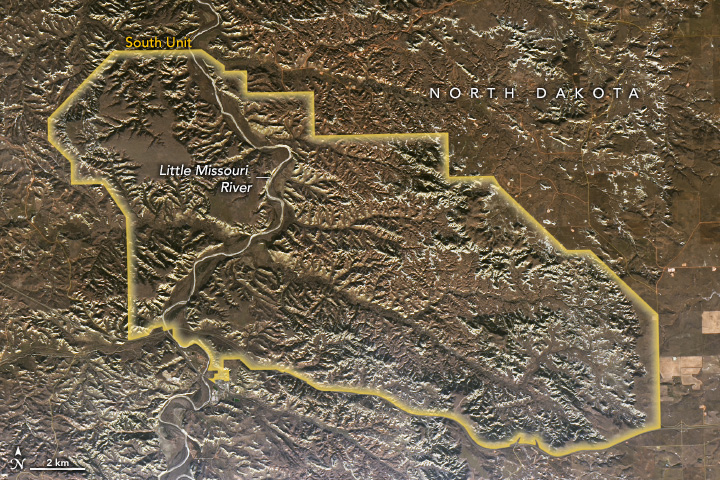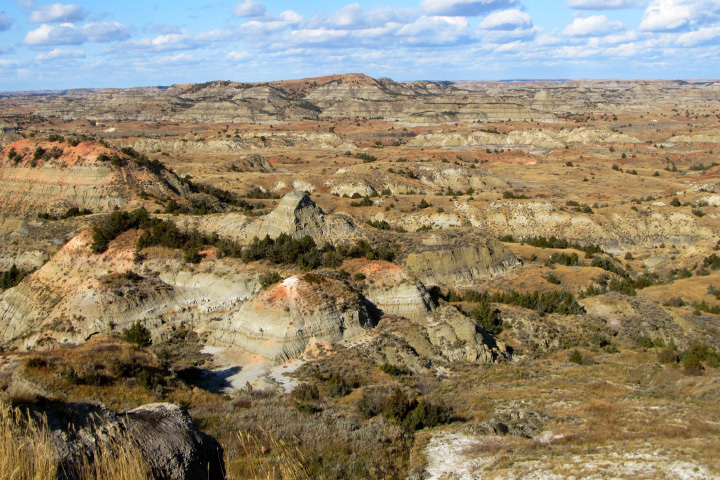
Good Lands for the 26th U.S. President
Downloads
- rooseveltnpwide_oli2_2023328.jpg (720x1736, JPEG)
- rooseveltnpwide_oli2_2023328_lrg.jpg (2402x5792, JPEG)
- roosevelt_lrg.jpg (2050x1367, JPEG)
- wide_annotated.jpg (720x1736, JPEG)
Metadata
- Sensor(s):
- Landsat 9 - OLI-2
- Data Date: November 24, 2023
- Visualization Date: December 11, 2023
Before he was president, Theodore Roosevelt tried his hand at ranching in North Dakota. When he first visited the Dakota Territory for a bison hunting trip in 1883, the wealthy New Yorker was immediately drawn to the cowboy lifestyle and desolate beauty of the badlands—a complex landscape of heavily weathered and eroded canyons, buttes, spires, and channels.
The OLI-2 (Operational Land Imager-2) on Landsat 9 captured this image of the meandering Little Missouri River cutting through the region on November 24, 2023. Flanking the river on both sides are networks of streams that, over time, carved the region’s soft sedimentary rocks into hills and ridges.
“The Bad Lands grade all the way from those that are almost rolling in character to those that are so fantastically broken in form and so bizarre in color as to seem hardly properly to belong to this earth,” Roosevelt said of the region’s exotic landscapes. “It was here that the romance of my life began.”
Heavily sculpted by water and wind, badland outcrops of sandstone, siltstone, and mudstone are often interspersed or capped with bursts of color, usually due to charred lignite coal transformed into a type of red rock called clinker. This erosion-resistant rock forms when the material above coal seams gets baked and fused by underground fires, which can occur naturally in this area.
Roosevelt was so enamored by the terrain and the potential for profit when he first visited that he invested in a cabin and cattle operation 7 miles (11 kilometers) south of Medora during the two-week trip. After the unexpected death of both his wife and mother just a few months later on Valentine’s Day, he returned to North Dakota in 1884 to grieve and take up ranching full time.
He thrived working with cattle at Elkhorn Ranch and later credited his time in North Dakota as launching him on a pathway to the presidency. However, the actual business of ranching proved challenging. Despite investing more than $80,000 on his operation, he lost much of his herd due to overgrazing and a harsh winter in 1886. By the time he sold off his last cattle interests in 1901, he had lost more than $20,000.
Theodore Roosevelt National Park was designated in 1947 as a memorial to Roosevelt, though at the time it only included the South Unit and Elkhorn Ranch Unit. The North Unit was added a year later.
Today, the park’s prairie grasslands and scattered forests are home to an array of wildlife including bison, elk, deer, pronghorn, and prairie dogs. Park rangers are managing these and hundreds of other animal and plant species in the hopes of ensuring they remain resilient to climate change.
Temperatures in North Dakota have risen by more than 2.6°F (1.4°C) since the beginning of the 20th century, according to NOAA’s state climate summaries. According to the U.S. Global Change Research Program’s Fifth National Climate Assessment, warming and overall aridity is expected to increase in the Northern Great Plains in the future as the climate changes, adding to the region’s already intense seasonal variability.
References
- Fifth National Climate Assessment (2023) Northern Great Plains. Accessed December 11, 2023.
- National Park Service (2007) NPS Geodiversity Atlas—Theodore Roosevelt National Park, North Dakota. Accessed December 11, 2023.
- National Park Service (2015) Theodore Roosevelt the Rancher. Accessed December 11, 2023.
- National Park Service History eLibrary (2004) Theodore Roosevelt and the Dakota Badlands. Accessed December 11, 2023.
- NOAA (2022) State Climate Summaries: North Dakota. Accessed December 11, 2023.
- North Dakota Notes (2005) North Dakota’s Clinker. Accessed December 11, 2023.
- Theodore Roosevelt Center (2013) A Risky Venture. Accessed December 11, 2023.
- Watts, S. (2003) Rough Rider in the White House. Accessed December 11, 2023.
NASA Earth Observatory images by Wanmei Liang, using Landsat data from the U.S. Geological Survey. Photograph by Douglas Schulze and courtesy of the National Park Service. Story by Adam Voiland.
This image record originally appeared on the Earth Observatory. Click here to view the full, original record.
